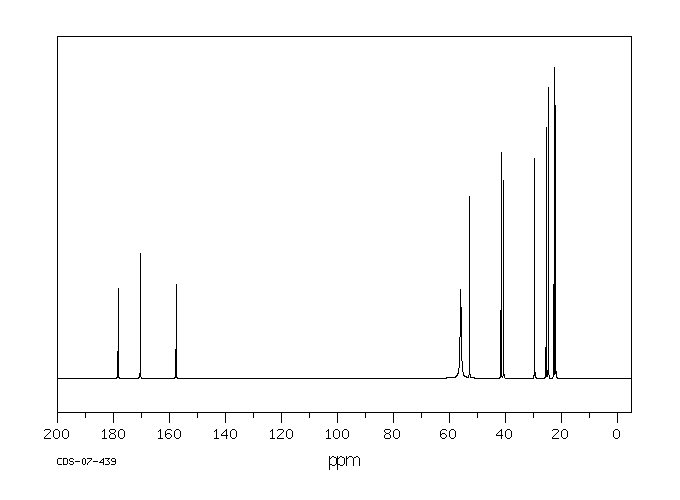亮氨酰-精氨酸 | 26607-15-8
中文名称
亮氨酰-精氨酸
中文别名
——
英文名称
LR
英文别名
L-leucyl-L-arginine;H-Leu-Arg-OH;L-Leu-L-Arg;Leu-Arg;H-Leu-Arg;leucinyl arginine;Leucylarginine;(2S)-2-[[(2S)-2-amino-4-methylpentanoyl]amino]-5-(diaminomethylideneamino)pentanoic acid
CAS
26607-15-8
化学式
C12H25N5O3
mdl
——
分子量
287.362
InChiKey
SENJXOPIZNYLHU-IUCAKERBSA-N
BEILSTEIN
——
EINECS
——
-
物化性质
-
计算性质
-
ADMET
-
安全信息
-
SDS
-
制备方法与用途
-
上下游信息
-
文献信息
-
表征谱图
-
同类化合物
-
相关功能分类
-
相关结构分类
物化性质
-
熔点:118-120 °C
-
密度:1.33±0.1 g/cm3(Predicted)
计算性质
-
辛醇/水分配系数(LogP):-4
-
重原子数:20
-
可旋转键数:9
-
环数:0.0
-
sp3杂化的碳原子比例:0.75
-
拓扑面积:157
-
氢给体数:5
-
氢受体数:5
SDS
上下游信息
-
上游原料
中文名称 英文名称 CAS号 化学式 分子量 —— Boc-Leu-Arg-OH 33966-64-2 C17H33N5O5 387.48 —— Z-Leu-Arg —— C20H31N5O5 421.497 -
下游产品
中文名称 英文名称 CAS号 化学式 分子量 (D-丙氨酰2)-亮氨酸 脑啡肽-精氨酸 Dalargin 81733-79-1 C35H51N9O8 725.845
反应信息
-
作为反应物:描述:亮氨酰-精氨酸 在 palladium on activated charcoal 、 氢气 作用下, 以 乙醇 、 水 、 N,N-二甲基甲酰胺 为溶剂, 反应 24.0h, 生成 (L)-Phe-(L)-Leu-(L)-Arg-OH参考文献:名称:Antiviral Immunotropic Agent for the Treatment of Acute Respiratory Viral Infections摘要:提议的治疗方法涉及医学,特别是药理学,涉及应用含有六肽基酪氨酸-D-丙氨酰-甘氨酰-苯丙氨酰-亮氨酰-精氨酸或其药学上可接受的盐的鼻用药物组合物,用于治疗急性呼吸道病毒感染(ARVIs),特别是由流感病毒引起的感染。公开号:US20190322701A1
-
作为产物:描述:参考文献:名称:Antiviral Immunotropic Agent for the Treatment of Acute Respiratory Viral Infections摘要:提议的治疗方法涉及医学,特别是药理学,涉及应用含有六肽基酪氨酸-D-丙氨酰-甘氨酰-苯丙氨酰-亮氨酰-精氨酸或其药学上可接受的盐的鼻用药物组合物,用于治疗急性呼吸道病毒感染(ARVIs),特别是由流感病毒引起的感染。公开号:US20190322701A1
文献信息
-
MODULATORS OF SESTRIN-GATOR2 INTERACTION AND USES THEREOF申请人:Navitor Pharmaceuticals, Inc.公开号:US20170114080A1公开(公告)日:2017-04-27The present invention provides compounds, compositions thereof, and methods of using the same.本发明提供了化合物、其组合物以及使用相同的方法。
-
A convenient synthesis of optically pure (2R, 3R)-2, 3- Epoxysuccinyl - dipeptides作者:Andreas Korn、Sabine Rudolph-Böhner、Luis MoroderDOI:10.1016/s0040-4020(01)85561-7日期:1994.1(2R,3R)-trans-Epoxysuccinyl-dipeptides (7a-7d) were synthesized by acylation of dipeptides with the N-hydroxysuccinimide or pentafluorophenyl ester of monoethyl (2R,3R)-trans-epoxysuccinate (6a,6b). A nucleophilic oxirane ring opening by N-hydroxysuccinimide and pentafluorophenol during the preparation of the active esters could not be observed. Subsequent saponification of the monoethyl ester 7a-7d with KOH in ethanolic solution allowed to produce the dipeptide derivatives as potassium salts (8a,8d) which were found to be stable on storage in the cold. The attempts to convert (2R,3R)-trans-epoxysuccinyl-glycyl-proline (7a) into the corresponding (2S,3S)-trans-epithiosuccinyl derivative via an oxygen sulfur exchange reaction with 3-methylbenzothiazole-2-thione failed completely as among the various products of unknown nature formed only the desulfurated fumaryl derivative could be isolated and characterized.(2R,3R)-反式-环氧丁二酰二肽(7a-7d)是通过使用单乙基(2R,3R)-反式-环氧丁二酸酯(6a,6b)的N-羟基丁二酰亚胺或五氟苯酯对二肽进行酰化反应合成的。在制备活性酯的过程中,无法观察到由N-羟基丁二酰亚胺和五氟苯酚引发的环氧乙烷环的亲核开环反应。随后,将单乙酯7a-7d与乙醇溶液中的氢氧化钾进行皂化反应,生成了作为钾盐的二肽衍生物(8a,8d),这些衍生物在冷处保存时表现出稳定性。尝试通过与3-甲基苯并噻唑-2-硫酮进行氧硫交换反应将(2R,3R)-反式-环氧丁二酰甘氨酰脯氨酸(7a)转化为相应的(2S,3S)-反式-环氧丁二硫酰衍生物,但这一尝试完全失败。在生成的各种未知性质产物中,唯一能分离并表征的是脱硫的富马酰衍生物。
-
Oligopeptide derivatives of ipoxantine endowed with immunomodulating activity and pharmaceutical compositions containing same申请人:Sigma-Tau Industrie Farmaceutiche Riunite S.p.A.公开号:EP0464009A2公开(公告)日:1992-01-02Ipoxantine derivatives of general formula (I): both as racemate and chiral forms and the salts thereof with pharmacologically acceptable cations, wherein n is an integer comprised between 2 and 6, and A is the residue of a dipeptide, tripeptide, tetrapeptide and pentapeptide selected, respectively, from the groups consisting of: (a) glycyl-aspartate, alanyl-glycine, glycyl-glycine, aspartyl-arginine, leucyl-arginine; (b) arginyl-lysyl-aspartate, aspartyl-lysyl-arginine, lysyl-prolyl-arginine, prolyl-prolyl-arginine, lysyl-histidyl-glycinamide, prolyl-phenilalanyl-arginine, phenylalanyl-prolyl-arginine; (c) arginyl-lysyl-aspartyl-valine, valyl-aspartyl-lysyl-arginine, threonylvalyl-leucyl-histidyne; and (d) arginyl-lysyl-aspartyl-valyl-tyrosine; are endowed with immunomodulating activity and can be formulated in orally or parenterally administrable pharmaceutical compositions.通式(I)的次黄嘌呤衍生物: 外消旋体和手性体及其与药理学上可接受的阳离子的盐类,其中 n 是介于 2 和 6 之间的整数,A 是二肽、三肽、四肽和五肽的残基,分别选自由下列组成的组 (a) 甘氨酰-天冬氨酸、丙氨酰-甘氨酸、甘氨酰-甘氨酸、天冬氨酰-精氨酸、亮氨酰-精氨酸; (b) 精氨酰-赖氨酰-天冬氨酸、天冬氨酰-赖氨酰-精氨酸、赖氨酰-脯氨酰-精氨酸、脯氨酰-脯氨酰-精氨酸、赖氨酰-组氨酰-甘氨酰胺、脯氨酰-苯丙氨酰-精氨酸、苯丙氨酰-脯氨酰-精氨酸; (c) 精氨酰-赖氨酰-天冬氨酰-缬氨酸、缬氨酰-天冬氨酰-赖氨酰-精 氨酰、苏氨酰-缬氨酰-亮氨酰-组氨酰;以及 (d) 精氨酰-赖氨酰-天冬氨酰-缬氨酰-酪氨酸;具有免疫调节活性,可配制成口服或肠外给药的药物组合物。
-
Modulators of sestrin-GATOR2 interaction and uses thereof申请人:Navitor Pharmaceuticals, Inc.公开号:US10414782B2公开(公告)日:2019-09-17The present invention provides compounds, compositions thereof, and methods of using the same.本发明提供了化合物、其组合物以及使用方法。
-
Modulators of Sestrin-GATOR2 interaction and uses thereof申请人:Navitor Pharmaceuticals, Inc.公开号:US10752644B2公开(公告)日:2020-08-25The present invention provides compounds, compositions thereof, and methods of using the same.本发明提供了化合物、其组合物以及使用方法。
表征谱图
-
氢谱1HNMR
-
质谱MS
-
碳谱13CNMR
-
红外IR
-
拉曼Raman
-
峰位数据
-
峰位匹配
-
表征信息
同类化合物
(甲基3-(二甲基氨基)-2-苯基-2H-azirene-2-羧酸乙酯)
(±)-盐酸氯吡格雷
(±)-丙酰肉碱氯化物
(d(CH2)51,Tyr(Me)2,Arg8)-血管加压素
(S)-(+)-α-氨基-4-羧基-2-甲基苯乙酸
(S)-阿拉考特盐酸盐
(S)-赖诺普利-d5钠
(S)-2-氨基-5-氧代己酸,氢溴酸盐
(S)-2-[[[(1R,2R)-2-[[[3,5-双(叔丁基)-2-羟基苯基]亚甲基]氨基]环己基]硫脲基]-N-苄基-N,3,3-三甲基丁酰胺
(S)-2-[3-[(1R,2R)-2-(二丙基氨基)环己基]硫脲基]-N-异丙基-3,3-二甲基丁酰胺
(S)-1-(4-氨基氧基乙酰胺基苄基)乙二胺四乙酸
(S)-1-[N-[3-苯基-1-[(苯基甲氧基)羰基]丙基]-L-丙氨酰基]-L-脯氨酸
(R)-乙基N-甲酰基-N-(1-苯乙基)甘氨酸
(R)-丙酰肉碱-d3氯化物
(R)-4-N-Cbz-哌嗪-2-甲酸甲酯
(R)-3-氨基-2-苄基丙酸盐酸盐
(R)-1-(3-溴-2-甲基-1-氧丙基)-L-脯氨酸
(N-[(苄氧基)羰基]丙氨酰-N〜5〜-(diaminomethylidene)鸟氨酸)
(6-氯-2-吲哚基甲基)乙酰氨基丙二酸二乙酯
(4R)-N-亚硝基噻唑烷-4-羧酸
(3R)-1-噻-4-氮杂螺[4.4]壬烷-3-羧酸
(3-硝基-1H-1,2,4-三唑-1-基)乙酸乙酯
(2S,4R)-Boc-4-环己基-吡咯烷-2-羧酸
(2S,3S,5S)-2-氨基-3-羟基-1,6-二苯己烷-5-N-氨基甲酰基-L-缬氨酸
(2S,3S)-3-((S)-1-((1-(4-氟苯基)-1H-1,2,3-三唑-4-基)-甲基氨基)-1-氧-3-(噻唑-4-基)丙-2-基氨基甲酰基)-环氧乙烷-2-羧酸
(2S)-2,6-二氨基-N-[4-(5-氟-1,3-苯并噻唑-2-基)-2-甲基苯基]己酰胺二盐酸盐
(2S)-2-氨基-N,3,3-三甲基-N-(苯甲基)丁酰胺
(2S)-2-氨基-3-甲基-N-2-吡啶基丁酰胺
(2S)-2-氨基-3,3-二甲基-N-(苯基甲基)丁酰胺,
(2S)-2-氨基-3,3-二甲基-N-2-吡啶基丁酰胺
(2S,4R)-1-((S)-2-氨基-3,3-二甲基丁酰基)-4-羟基-N-(4-(4-甲基噻唑-5-基)苄基)吡咯烷-2-甲酰胺盐酸盐
(2R,3'S)苯那普利叔丁基酯d5
(2R)-2-氨基-3,3-二甲基-N-(苯甲基)丁酰胺
(2-氯丙烯基)草酰氯
(1S,3S,5S)-2-Boc-2-氮杂双环[3.1.0]己烷-3-羧酸
(1R,5R,6R)-5-(1-乙基丙氧基)-7-氧杂双环[4.1.0]庚-3-烯-3-羧酸乙基酯
(1R,4R,5S,6R)-4-氨基-2-氧杂双环[3.1.0]己烷-4,6-二羧酸
齐特巴坦
齐德巴坦钠盐
齐墩果-12-烯-28-酸,2,3-二羟基-,苯基甲基酯,(2a,3a)-
齐墩果-12-烯-28-酸,2,3-二羟基-,羧基甲基酯,(2a,3b)-(9CI)
黄酮-8-乙酸二甲氨基乙基酯
黄荧菌素
黄体生成激素释放激素(1-6)
黄体生成激素释放激素 (1-5) 酰肼
黄体瑞林
麦醇溶蛋白
麦角硫因
麦芽聚糖六乙酸酯
麦根酸







